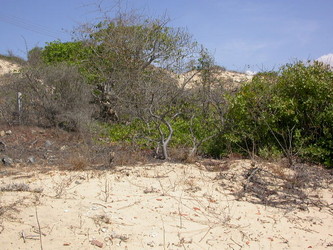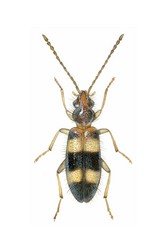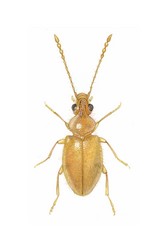Notoxinae
Dmitry Telnov- Hypaspistes Waterhouse, 1886
- Leptoprion Krekich-Strassoldo, 1914
- Mecynotarsus LaFerté-Sénectčre, 1849
- Notoxus Geoffroy, 1762
- Plesionotoxus Chandler, 1978
- Pseudonotoxus Pic, 1899
- Squamanotoxus Chandler, 2001
Introduction
The Notoxinae or monoceros beetles are probably among the most easily recognizable beetles, because of the presence of a prominent denticulate anterodorsal horn on the pronotum. This subfamily has a cosmopolitan distribution, and about 400 species in seven genera are known; no fossil records are hitherto known for Notoxinae. Representatives of this subfamily occur in various habitats from subboreal forests to savannahs and rainforests. They are most diverse in the African subcontinent.
Characteristics
Frontoclypeal suture well developed. Mandibles bidentate at apices. Apical margin of mandibles enlarged like thick flanges (exception - genus Leptoprion). Eyes large, entire. Vertex smooth and dorsally impressed. Neck short and broad, 1/2-1/3 of maximum head width.
Pronotum short and broad, with prominent laterally dentate antebasal horn over the head. Cervical notches lateral to the neck. Antebasal sulcus well developed, complete or with median break. Mesosternum triangular.
Elytra usually without rows of punctures.
Metacoxae slightly to broadly separated by intercoxal projection. Male genital organs with phallobase and separate parameres. Penis free. Sternite IX linear.
Many canthariphilous forms are known in this subfamily, especially among Notoxus. The pronotal horn is commonly used for burrowing in sandy soils.
Classification
Note: all taxa below are listed alphabetically.
- Hypaspistes Waterhouse, 1886 - Africa, SE Asia
- Leptoprion Krekich-Strassoldo, 1914 - Indonesia (Sumatra) (monotypic genus)
- Mecynotarsus LaFerté-Sénectère, 1849 - cosmopolitan
- Notoxus Geoffroy, 1762 - cosmopolitan
- Plesionotoxus Chandler, 1978 - South America
- Pseudonotoxus Pic, 1899 - Africa, Eurasia, Australia
- Squamanotoxus Chandler, 2001 - South & North Americas
Biology and Ecology
Adults are omnivorous, often feeding on pollen (taking part in flower pollination) or plant exudates; cases of micropredation have also been registered. Most Notoxinae prefer sandy soils for laying eggs. Many species, particularly of Notoxus, are known to be canthariphilous and are attracted to cantharidin. The cantharidin is mostly obtained by males. In some groups, males bear secretory glands that concentrate the cantharidin in special canals or pits at the elytral apices, indicated as apical tubercles. Being highly poisonous, cantharidin is used by Notoxinae as a feeding deterrent against predators or acts as a kairomone for braconid wasps, endoparasites of Notoxus. Females take the cantharidin into their bodies when feeding upon the secretions of the males. Females also pass the cantharidin to the eggs and larvae and it is used for protection by them.


© 2007 Andreas Pütz. Coastal dunes in South Vietnam are the typical habitat of Notoxus psammophilus.
Larvae of one Notoxus species were recorded from sweet potato tubers, but in most cases they develop in loose, sandy soils.
Two to four weeks after the copulation takes place, the female lays whitish, oval eggs singly or in little piles in protected places. Usually the female digs a tunnel into sandy soil, where the eggs are laid. Development of eggs takes about 12 days and the larval period ranges from 6-8 weeks. Prior to pupation, the larvae burrow a short depth into the soil and encase themselves in a slightly elongate puparium formed from pieces of debris or sand. The pupal stage takes up to two weeks.
Title Illustrations

About This Page
Dmitry Telnov

The Entomological Society of Latvia
Correspondence regarding this page should be directed to Dmitry Telnov at
Page copyright © 2011 Dmitry Telnov
All Rights Reserved.
- First online 06 January 2011
- Content changed 06 January 2011
Citing this page:
Telnov, Dmitry. 2011. Notoxinae. Version 06 January 2011 (under construction). http://tolweb.org/Notoxinae/145031/2011.01.06 in The Tree of Life Web Project, http://tolweb.org/










 Go to quick links
Go to quick search
Go to navigation for this section of the ToL site
Go to detailed links for the ToL site
Go to quick links
Go to quick search
Go to navigation for this section of the ToL site
Go to detailed links for the ToL site